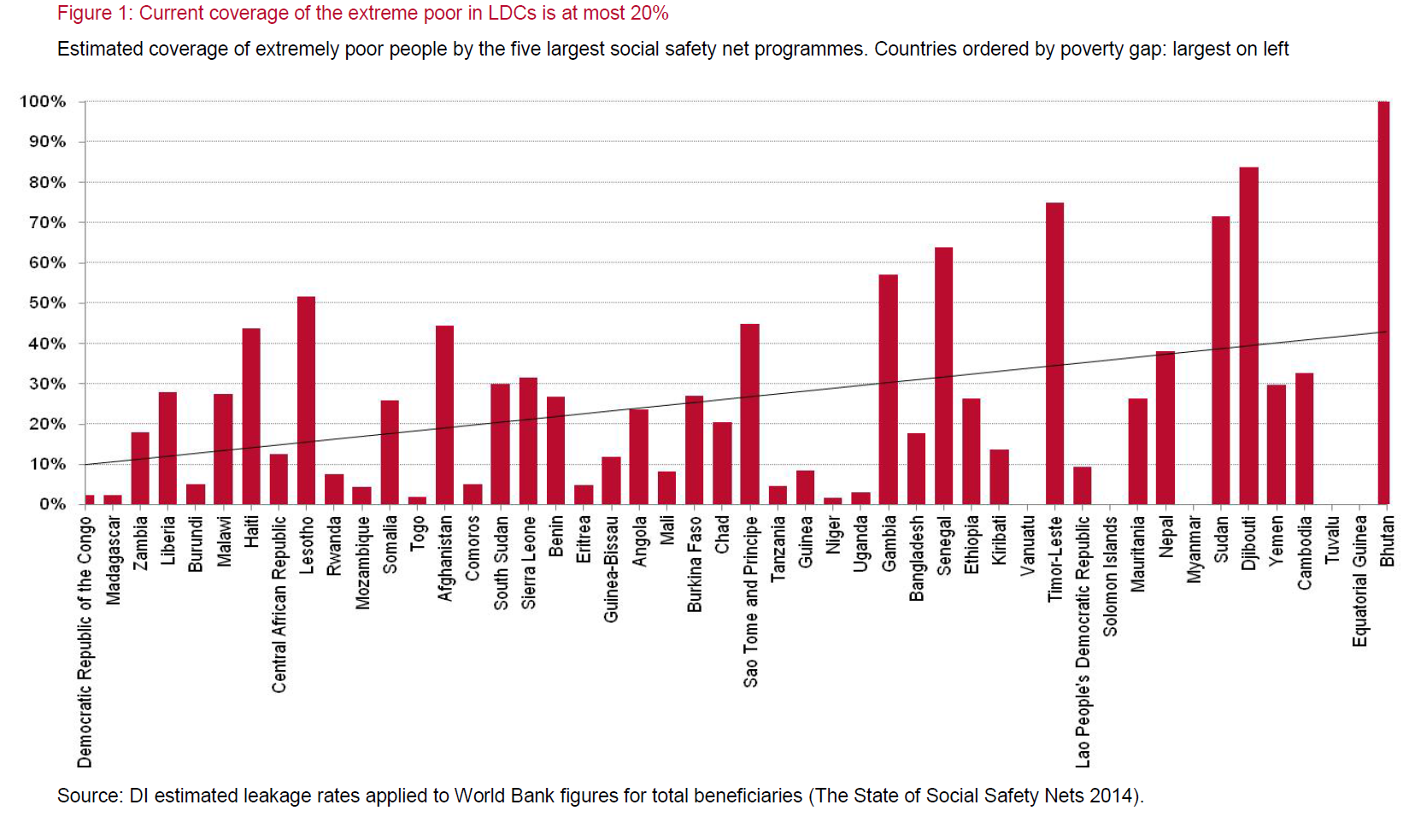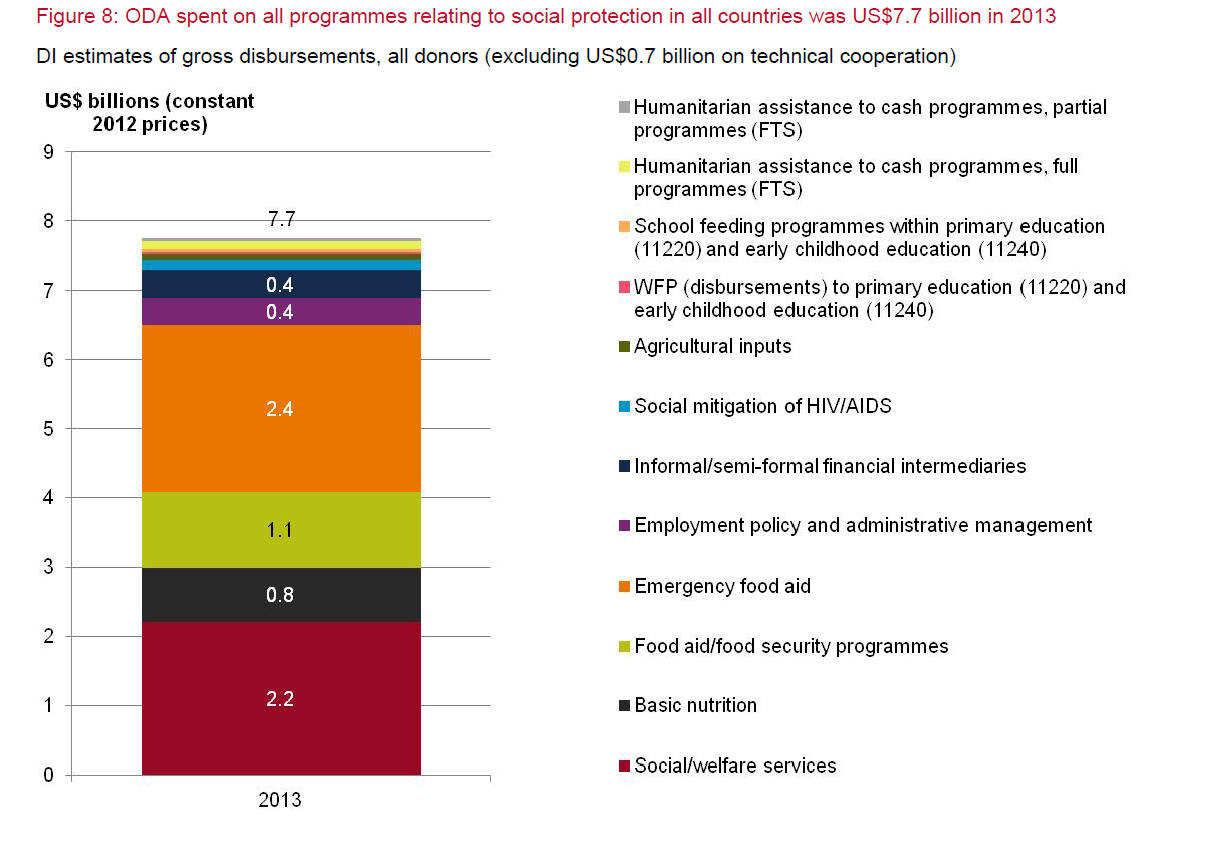Financing for social protection in LDCs
Support for social protection needs to increase if LDCs are to meet post-2015 targets
Current levels of social protection investments – domestic and international – in least developed countries (LDCs) are not enough to respond to extreme poverty needs. DI’s latest report on social protection financing and coverage shows that increases in official development assistance (ODA) will be needed.
Our recent data blog shows that LDCs face complex challenges in ending poverty that may require sustained support and investment from ODA providers. The role of social protection programmes in ending poverty has seen increasing support in recent years, from both the international community and national governments. Target 1.3 in the (under Goal 1: End poverty in all its forms everywhere) is to “implement nationally appropriate social protection systems and measures for all, including floors, and by 2030 achieve substantial coverage of the poor and the vulnerable.” As our report shows, for LDCs, funding and delivering on this target will be a significant but not impossible challenge.
There is a growing body of evidence on the impact that social protection has on reducing poverty in countries as diverse as Brazil, Ethiopia, South Africa, Malawi, Kenya, India and Rwanda. All countries now have at least one type of social protection programme targeted at the poorest and most vulnerable people.
However, in LDCs, we find social protection programmes are on average only reaching 20% of those living in extreme poverty (below PPP $1.25 a day). Only 10 of the 48 LDCs have coverage of more than 30% and these tend to be countries with lower levels of poverty. Even where extremely poor people are reached, the level of transfer is much less than that needed to sustainably lift poor people out of extreme poverty – just 10% in sub-Saharan Africa. Significant additional financial resources are needed in most LDCs.
ODA for social protection: current spending
We analysed financing support from Organisation for Economic Cooperation and Development (OECD) Development Assistance Committee (DAC) donors for all forms of social protection-related programmes. We deliberately developed a broad definition of social protection so as not to overestimate the funding gap. Using this broad definition the current annual spend on social protection ODA is US7.7 billion in 2013 (excluding US$0.7 billion on technical cooperation).
In 2013, the five donors providing most social protection aid – accounting for around 80% of total spend – were the US, UK, the EU, the International Development Association and Japan. The next five are Canada, Germany, World Food Programme, Norway and Australia.
As a sector, ODA spending on social protection has consistently accounted for a lower percentage of total ODA than either education or health has, never rising to more than 12% of the total ODA spend from DAC donors.
Domestic financed expenditure in LDCs can’t fill financing gap
The cost of providing the transfer needed to close the extreme poverty gap in LDCs is US$49 per person per year, taking into account start up and administration costs and allowing for leakage. This is less than the costs for the education and health sustainable development goals, US$60 and US$86 respectively.
Current domestic spending on all forms of social protection programmes is on average US$10 per person in LDCs, equivalent to just over 1% of GDP. If, for example, LDCs increased their tax to gross domestic product (GDP) ratio to 20% (from the current average of 17%) and allocated 10% to targeted social protection programmes, spending would rise to 2% of GDP, US$16 per person. Yet even in this scenario, there would still be a funding gap of US$33 per person in LDCs.
Current DAC donor funding for all forms of social protection-related programmes in LDCs averages US$4 per person per year. As a result we estimate 88% of the financing gap is currently unfunded. (This compares with recent estimates of the unfunded element for education at 67% and health 50%.)
An increase in ODA will be needed to support LDCs to deliver the post-2015 goal of ending poverty
Our analysis suggests the increase in ODA required to deliver social protection programmes at the scale needed to end poverty in all LDCs is equivalent to 0.1% of OECD DAC donors’ gross national income (GNI). Given the priority attached to ending extreme poverty and the limited scope for LDCs to increase domestic resources for funding social protection in the next 15 years, financing for social protection should be high on the agenda for governments preparing for the UN Financing for Development (FFD3) conference this July, as ambitious financing commitments from all actors will be essential.
Further, identifying the domestic actions and the international cooperation that will be required to support delivery and increase coverage and scale-up of social protection in LDCs should be high priority. This needs to be considered at global, regional and national levels, as part of UN post-2015 sustainable development negotiations and post-2015 implementation.
Download the data in Excel and CSV – Figure 1, Figure 8
Notes
Methodology:
For the purposes of this report we have adopted a broad defintion of social protection. We include any public action – carried out by the state or privately – that enables people to deal more effectively with risk and their vulnerability to crises and changes in circumstances (such as unemployment or old age), and helps tackle extreme and chronic poverty. As health financing issues are already being covered in the post 2015 debate we have focused here on the non-health elements of social protection.
Related content
Priorities for the UK’s incoming Secretary of State Alok Sharma
As Alok Sharma takes office as Secretary of State, DI's Amy Dodd sets out key priorities for the UK and its global development agenda.
From review to delivery on the Global Goals – what should the immediate priorities be for the UK government?
On 26 June, the UK government published its Voluntary National Review measuring delivery against the Global Goals - but does it accurately capture progress?
Three priorities for the High-level Political Forum 2019
DI Director of Partnerships & Engagement Carolyn Culey sets out three key priorities for closing the gap between the poorest and the rest at HLPF 2019

